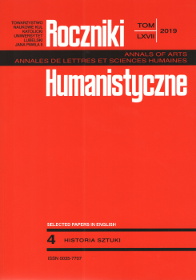The Reception of the Engravings of Gottfried Bernhard Göz’s Marian Series in the Monumental Painting of the Lviv Circle in the 18th Century
The Reception of the Engravings of Gottfried Bernhard Göz’s Marian Series in the Monumental Painting of the Lviv Circle in the 18th Century
Author(s): Janina DzikSubject(s): Fine Arts / Performing Arts, Visual Arts, History of Art
Published by: Towarzystwo Naukowe KUL & Katolicki Uniwersytet Lubelski Jana Pawła II
Keywords: G.B. Göz’s engravings; monumental painting
Summary/Abstract: The Polish version of the article was published in Roczniki Humanistyczne vol. 63, issue 4 (2015). The graphic series dedicated to the Mother of God, defined as Sub tuum praesidium confugimus, by Gottfried Bernhard Göz (1708–1774) was an inspiration for the monumental painting of the Rococo period in Poland in the times of the Saxon kings. The series of engravings with a devotional character made with the stipple engraving technique presents 12 signed Marian scenes: the Immaculate Conception of the Blessed Virgin Mary, Mary’s Birth, the Presentation of Mary, Mary and Joseph’s Matrimony, the Annunciation, the Visitation, the Purification, the images of Our Lady of Sorrows, and the Assumption. Other scenes are connected with Mary’s patronage – as the Queen of the Rosary—and her intercession. The prints, as researchers of Göz’s work assume, prove his mature style that was shaped in the years 1737–1740, when he formed a publishing “company” together with the Klauber brothers, Joseph Sebastian and Johann Baptist. He used the motifs occurring in the series many times e.g. on the vault of the nave in the Dominican nuns’ St Stefan Church in Habsthal (1748; Upper Swabia), in the sketch and painting for the Cistercian monastery in Birnau (1748–1750). These motifs were also found in Bavarian Marian shrines, e.g. Frauenchiemsee, Maria Mitleid Kapelle and Mater Dolorosa Kapelle with paintings by Balthasar Furtner (1761) and in a church in Niederaschau and Kleinmariazell (1763–1765). References to the series may also be found in the area of Slovenia, i.e. on the vault of Grajska Kapela in Novo Celje (1758–1763).The prints were known to the circle of Lviv artists active in the 18th century and they were used as models for numerous figural compositions. First of all the Lviv painter Stanisław Stroiński (1719–1802) used them for the decorations, among others, of the interior of the Franciscan Marian sanctuary in Leżajsk, in the Franciscan Holy Spirit Church in Krystynopol (1756–1759 (now Chervonohrad in Ukraine), and in the decoration of St Anne’s Chapel in the Holy Trinity Benedictine Church in Przemyśl. The series of prints was also used by the painter Gabriel Sławiński in the decoration of the chancel in St Lawrence Parish Church in the village of Żółkiewka and on the vault of the post-Pauline St Louis Church in Włodawa.The engravings are a significant model for Polish painting because of their style, technique and original approach to the conventional religious theme.
Journal: Roczniki Humanistyczne
- Issue Year: 67/2019
- Issue No: 4SP
- Page Range: 7-32
- Page Count: 26
- Language: English

